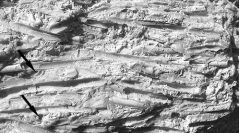

 Comptes Rendus Palevol
6 (1-2) - Pages 73-85
Comptes Rendus Palevol
6 (1-2) - Pages 73-85The first prograding bioclastic bodies of the Messinian carbonate platform from Melilla-Nador (Morocco) contain numerous feeding tubes of Vermetidae (Petaloconchus) shells. This accumulation results from dense littoral settlements of vermetids, sometimes preserved in place in the higher part of the system, having produced during their life several tubes in a short duration, probably under repeated stressing environmental conditions. The progradation of the system allows, under constant sea level, the continuity of the process. This original construction–cutting–accumulation phenomenon could be related to the fluctuations of the palaeoproductivity characterizing this period.
Vermets, carbonate build-ups, bioaccumulations, Messinian, Mediterranean, Morocco